5 hospital chefs won 2020 with plant-forward recipes
Health Care Culinary Contest finalists revealed, winner to be announced in March

Health care culinary professionals across the country are taking their menus to new levels in creativity and flavor, all powered by plants.
Health Care Without Harm and Practice Greenhealth teamed up with Menus of Change, an initiative of The Culinary Institute of America and Harvard T.H. Chan School of Public Health to host our third Health Care Culinary Contest.
These five chefs, our Health Care Culinary Contest finalists, persevered to cook and serve healthy food when our patients and communities needed it the most.
Meet the chefs and hear the stories behind their delicious #plantforward recipes.
- Davis Hospital and Medical Center’s sweet potato tempura and black bean tacos
- MetroHealth System’s Spanish frijoles salad with plantain chips
- NYU Langone Health’s autumn vegetable curry
- Stanford Health Care’s adobo de la tierra
- Winchester Hospital’s pumpkin seed-encrusted eggplant rollatini
Honorable mentions
- Mayo Clinic Arizona’s Mideastern-style vegetable stew
- University of Mississippi Medical Center’s “cheese” grits and grillades
Davis Hospital and Medical Center’s sweet potato tempura and black bean tacos

“With the chill of fall in the air, we wanted to embrace the season and give back to our dedicated essential hospital team members and physicians by creating and sharing delicious and nourishing comfort foods.”
— Neil Reese
Hospital
Davis Hospital and Medical Center in Layton, Utah
Chefs
Neil Reese and Justin Norris (recipe creator)

Meet the chef
Neil Reese grew up in his grandmother’s and mother’s kitchens and this is where he developed his love and passion for food and cooking. Over the past 15 years, Reese has worked in a variety of positions and honed his craft in health care and corporate dining kitchens at Pioneer Valley Hospital, Salt Lake Regional Medical Center, Micron, Sutter Physician Services, and Davis Hospital and Medical Center.
Reese is inspired by international flavors and local ingredients and challenges himself and his team each week to create amazing flavors with scratch made preparation techniques. Reese’s infectious optimism and friendly personality invites hospital team members, physicians, patients, and guests to check out the café frequently to see what delicious meal awaits them.
What is the story of your recipe?
With the chill of fall in the air, we wanted to embrace the season and give back to our dedicated essential hospital team members and physicians by creating and sharing delicious and nourishing comfort foods. Thomas Cuisine at Davis Hospital and Medical Center proudly serves meals made from fresh, real ingredients. We were excited to incorporate some of our favorite seasonal ingredients that are nutrient-dense and loaded with fiber and phytonutrients in creative and new ways. This was the inspiration for our sweet potato tempura and black bean street tacos.
These tacos combine crunch from the sweet potatoes, savory and spice from the black beans, sweet and smokiness from the roasted red peppers, pepper and herb nuance of arugula, salty flavor of the cotija, creaminess of the avocado crema, and tang of the fresh lime into a delicious meal that our customers crave.
The arugula in the tacos was sourced locally from Snuck Farms in Pleasant Grove, Utah, about 40 miles away from the hospital. Snuck Farms uses both hydroponic farming and organic soil farming methods to grow the large variety of crops produced on their farm. Their greens are tender, fresh, and full of vibrant flavor.

How did you feature your recipe?
We featured our sweet potato tempura and black bean street tacos in our physician’s lounge. Reese welcomed the physicians and administrators with a smile and built their tacos to order. Some physicians were very excited, and some were cautiously willing to try.
Resoundingly, they enjoyed the dish because the flavors and textures of the tacos excite the palate. A couple of physicians even came back for more. We promoted our plant-forward initiative on our digital monitor and shared copies of the recipe (scaled for 6 servings) for those that wanted to make it at home. Thomas Cuisine also promoted our plant-forward offerings on social media and encouraged customers to look for these amazing dishes throughout the month.
MetroHealth System’s Spanish frijoles with plantain chips

“I want to share the flavors of my culture but also show that eating healthy does not have to be expensive.”
— Erieberto Caraballo
Hospital
The MetroHealth System in Cleveland, Ohio
Chef
Erieberto Caraballo

Meet the chef
I am the sous chef at MetroHealth. My cooking influences are representative of my Latin culture. I live in the Clark-Fulton neighborhood, which is the same neighborhood that MetroHealth’s main campus is located. My goal is to share the flavors of my culture, while also connecting MetroHealth to our Latin American community.
What is the story of your recipe?
Culture-forward food has always been a central focus in my culinary initiatives. My name is Erieberto Caraballo and I am the sous chef at the MetroHealth System in Cleveland, Ohio. I come from the Clark-Fulton neighborhood, which is the same neighborhood that MetroHealth’s main campus is located. The reason I chose to be a part of MetroHealth is because I believe in their vision of serving the community and mission of “leading the way to a healthier you and healthier community.” This is the community that has shaped me into who I am today. I grew up in this area and feel it is important to give back and connect with those who live here. I have seen this community go through a lot of ups and downs. The Clark-Fulton community is on the rise and MetroHealth has a lot to do with this positive change.
The neighborhood is predominately Latin American, which is my nationality as I am of Puerto Rican descent and my culinary techniques reflect this. I chose to prepare a Spanish vegan frijoles salad served with plantain chips, which is being sold in our retail café as a composed grab and go option. I chose this because the ingredients represent the flavors of this community and support healthy eating habits. It is also in line to help the people of our organization meet their MetroHealthy wellness goals, which is an internal program committed to promoting a healthier community, including the well-being of our employees.
COVID-19 has changed the way a lot of us do our grocery shopping. Less frequent trips to the grocery stores on a minimal budget with purchases that focus more on shelf stable options, like canned goods. Beans and fresh cilantro are staples for Latin cooking, which are cost-effective ingredients. I chose to serve this dish alongside sweetened dried plantain chips, as this is also a cost-effective product and readily available in Latin food stores; specifically, available at most corner stores in the Clark-Fulton neighborhood as a sought-after product. I want to share the flavors of my culture but also show that eating healthy does not have to be expensive.

How did you feature your recipe?
The Spanish frijoles salad with plantain chips is promoted through a few different outlets. We use AppSpace to display digital images of various foods and Food Services initiatives, which are being displayed. We also send out a MetroHealthy tip of the week to our internal employees. Our MetroHealthy tip includes the recipe and information about this product being available at our grab and go coolers. MetroHealth sends out a community newsletter called “Simply Well” which is focused on keeping families in the community healthy. We plan on publishing this content in the upcoming newsletter. We also plan to develop this content on branded cards to distribute to families in our Clark-Fulton neighborhood as a means to connect MetroHealth with its community. The Spanish frijoles will also be sampled in our cafe to our customers in order to promote the new product.
Closing thoughts
This month we have been focused on eating healthy on a budget. One of the most expensive parts of the food bill is meat. One cost-cutting idea is to plan some meatless meals that are still filling and healthy. Using legumes (starchy beans) is a good way to accomplish this. This meal uses traditional Puerto Rican ingredients that are easy to find and affordable.
NYU Langone Health’s autumn vegetable curry

“This recipe and cooking class was well-received and we plan to continue to develop new and exciting vegetarian recipes to share with our staff moving forward.” — Jeffrey Held
Hospital
NYU Langone Health in New York City, N.Y.
Chef
Jeffrey Held

What is the story of your recipe?
This recipe was developed as part of our monthly employee engagement healthy cooking class called Cooking for Wellness at NYU Langone Health. We focus on a specific theme each month and almost entirely adhere to vegetarian and/or vegan recipes. In this case, we were utilizing the local and seasonal ingredients from our NYC farmer’s markets in mid-October, while also sharing some specific culinary techniques to improve the quality of the food. We demonstrated toasting spices, caramelizing vegetables and tomato paste, as well as toasting basmati rice to enhance the flavor profile and complexity of the dishes. All of this was in order to help teach our employees how to develop deep and complex flavors in plant-based cooking. This recipe also incorporates many immune-boosting foods, like turmeric and cauliflower, which are especially important for this time of year.
The seasonal produce was purchased from the Union Square Farmers’ Market, which is less than 1.5 miles from our main hospital and 0.4 miles from our Orthopedic Hospital. This year-round market hosts local farmers and producers, collects food scraps for compost, and accepts EBT/SNAP. In the past, we have worked with GrowNYC, the nonprofit organizer of this market, to bring food educational events to our orthopedic hospital, to explore community-supported agriculture (CSA) options, and to overall encourage the use of their farmers’ markets near our main hospitals to staff.
The spices used are purchased from Kalustyan, who has extensive sustainability practices throughout their supply chain. Kalustyan is also continuously involved in local- and state-wide events that support their local community and has a brick and mortar store four blocks away from our main hospital.
This recipe and cooking class was well-received and we plan to continue to develop new and exciting vegetarian recipes to share with our staff moving forward.
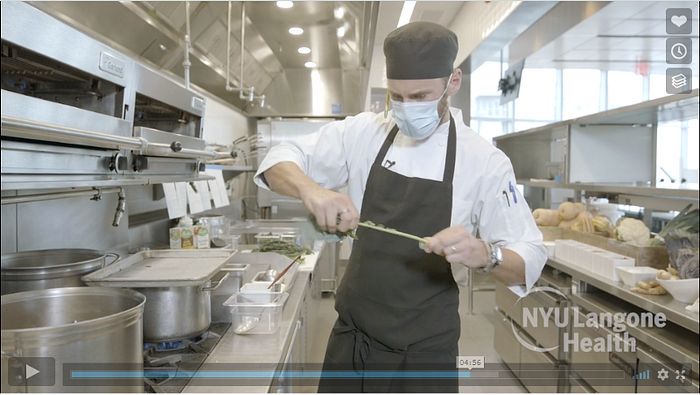

How did you feature your recipe?
This recipe was shared on our monthly ‘Cooking for Wellness’ series, which features cooking demonstrations that teach staff how to create tasty and healthy recipes at home. Led by NYU Langone chef, Jeffrey Held, and registered dietician, Edwina Rich, the video demonstration educates staff on the importance of seasonal ingredients and the nutritional benefits of the many plant-based ingredients. For example, sweet potatoes are rich in beta carotene; chickpeas are a great plant-based source of zinc; and in-season vegetables are more delicious, more affordable, and nutrient dense.
Samples of the autumn vegetable curry were also given to staff in our cafeteria, along with recipe cards that staff can collect and use at home. This demonstration, samples, and recipe cards are simple and engaging ways to empower staff to explore new recipes at home and incorporate healthy ingredient alternatives.
Stanford Health Care’s adobo de la tierra

“I feel blessed to be part of an organization where I have the opportunity, each day, to provide a moment of respite through my delicious food.”
— Noriel San Pedro
Hospital
Stanford Health Care, Stanford, Calif.
Chef
Noriel San Pedro

Meet the Chef
Born, raised and immersed in the culture of the Philippines, Noriel first came to the United States in 2015 where he and his wife, Rosa, both held positions at Texas Tech Medical Center. Three years later, Noriel and his wife found themselves packing up and moving to Palo Alto, Calif. for their new roles within the health care sector. Currently, San Pedro proudly serves as the operations supervisor for food services at Stanford Health Care. A food service veteran with over 10 years in the food industry, San Pedro brings with him the experience of the Philippine food scene, focused on bold spices, flavors and influences that evoke the simplicity of food which nourishes the body and soul. San Pedro feels blessed to be part of an organization where he has the opportunity, each day, to provide a moment of respite through his delicious food.
What is the story of your recipe?
“Adobo de la tierra” represents Chef Noriel San Pedro’s passion for cooking while celebrating the bounty provided by our rich soil. San Pedro’s inspiration for the dish harkens back to his youth when Noriel’s mother would prepare the traditional Filipino Adobo using items which were available in the small town of San Ricardo, located in the province of Nueva Ecija, Philippines. This is where Noriel began to gain an understanding of living off the land and develop his love for preparing delicious meals.
This dish represents Noriel’s version of his childhood favorite but with a plant-forward focus. The earthiness of the sauce provided by the mushrooms, the firm texture of the tofu, and the combination of the sweet and spicy atchara work together to awaken your palate; carnivores need not miss the animal protein from the traditional version.
In his salute to this Filipino favorite, San Pedro brings together the best that Northern California has to offer, from celebrating the handcrafted locally-made Hodo organic tofu to paying respect to the generations of Salinas valley farmers who tirelessly devote their lives to provide access to healthy, sustainably grown food.
San Pedro’s devotion to his craft, and his adobo de la tierra, are well-suited in the food transformation theme of Stanford Health Care to bring fruits and vegetables to the center of the plate, reduce the use of animal proteins, and do so with the mantra “globally inspired, locally crafted”.

How did you feature your recipe?
Stanford Health Care Food Services entered into a campaign to promote their adobo de la tierra during the month of November, 2020. During that time, we developed various print and digital assets featuring San Pedro and his adobo de la tierra dish to post in our cafeteria space, our intranet pages, and within our social media pages. These assets were used prior to, and during, our featured service within the retail cafeteria. We also developed patient dining flyers and a special menu which detailed the dish which were distributed to various patient care managers through the hospital community. Our dietary assistants, who speak directly with our patients and their caregivers, were also provided with details and flyers regarding the specifics of adobo de la tierra. San Pedro presented the dish to our customers on several occasions, answered their questions, and directed them to recipe cards which we recently developed.
Closing thoughts
San Pedro feels blessed to be part of an organization where he has the opportunity, each day, to provide a moment of respite through his delicious food.
Winchester Hospital’s pumpkin seed-encrusted eggplant rollatini with apple cider cream sauce
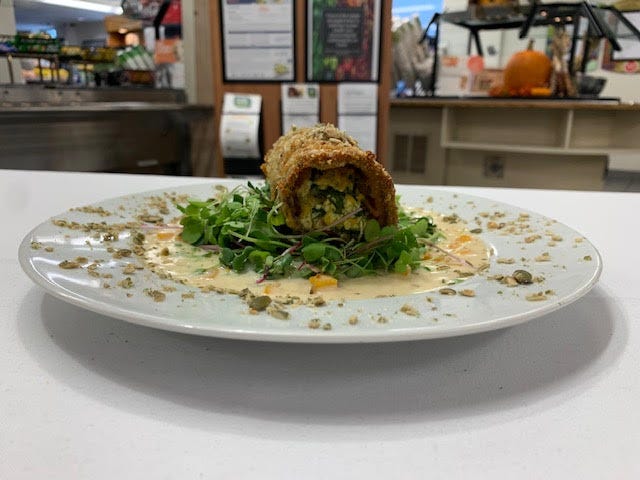
This contest has been a team effort from Winchester Hospital. Our chefs, retail managers and dietitians assisted in the creation and marketing of this recipe.
Hospital
Winchester Hospital, Winchester, MA
Chef
Alex Calderon and Sean Mahoney

Meet the Chefs
Alex calderon — Chef supervisor at Winchester Hospital’s 620 Cafe for the past 8 years. He helped open this new location at our Ambulatory Surgical Center and has done an amazing job overseeing this operation. Alex has worked at Winchester Hospital for over 18 years. He is originally from El Salvador and has honed culinary skills over many years and is an amazing culinary talent.
Sean Mahoney — Executive chef at Winchester Hospital for three years. He supported Calderon in this recipe creation.
What is the story of your recipe?
This contest has been a team effort from Winchester Hospital. Our chefs, retail managers and dietitians assisted in the creation and marketing of this recipe.
Alex Calderon, chef supervisor, was the inspiration in developing the recipe and has a passion for cooking. His presentation of the fall-themed eggplant rollatini was a great success and enjoyed by our hospital staff. He combined sustainable and local butternut squash from Czajkowski Farm, apple cider from Carlson Farm, and eggplant along with many plant based ingredients and produced a delicious rollatini with a sweet, savory and crunchy bite.
Wellness is one of Winchester Hospital’s goals and encouraging our staff and community to eat more plant-based has many numerous health benefits. This contest was fun and rewarding especially during these COVID-19 months, but more importantly, plant-based recipes encourage people to try plant-based food, which is always a positive thing.

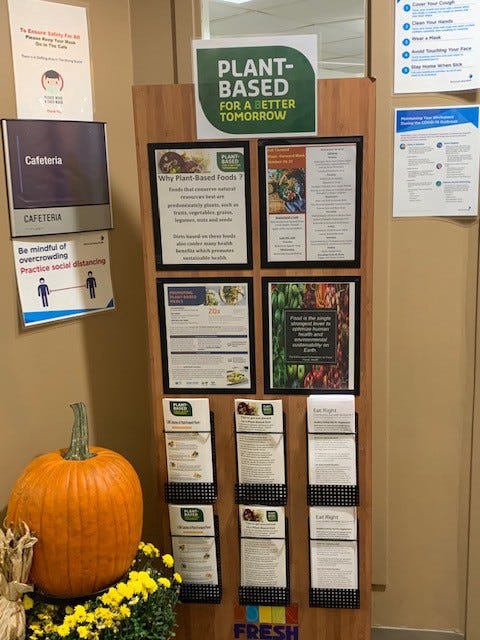
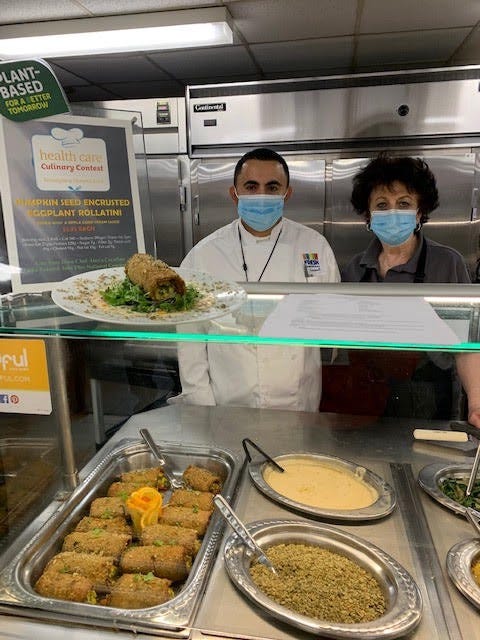
How did you feature your recipe?
We hosted a tasting event and marketed the recipe through the hospital’s intranet and our Winnotes newsletter to all employees. We also posted flyers in elevators and in retail areas. We shared our entry with key stakeholders in the hospital through our leadership meeting, the sustainability committee, the wellness committee and our communications department.
Honorable mentions
Mayo Clinic Arizona’s Mideastern-style vegetable stew
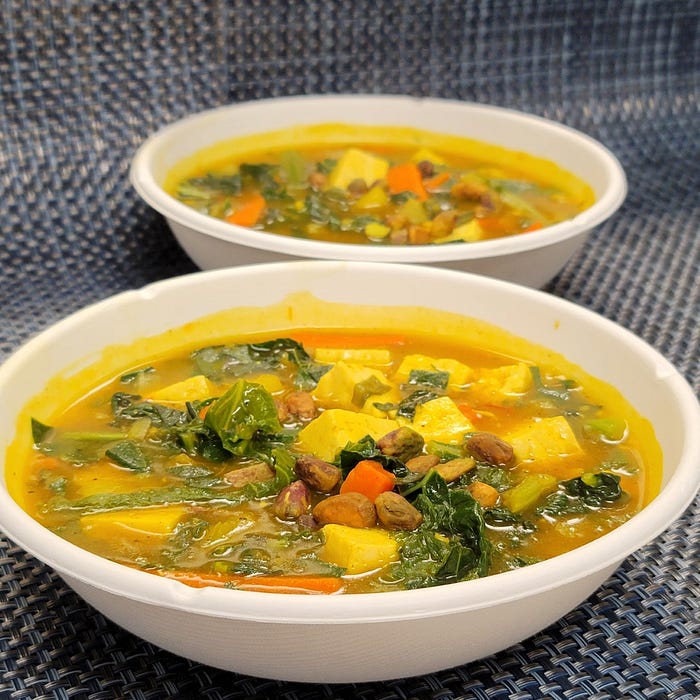
“One of the biggest fears with our customers is that plant-based foods that create dishes are flavorless. This recipe breaks those barriers by using very strong aromatics such as cardamom, cinnamon, cumin, and saffron.”
— Joseph Kraft
Hospital
Mayo Clinic Arizona in Phoenix, Ariz.
Chef
Joseph Kraft
Meet the chef
Joseph Kraft is a certified executive chef. He has been a member of the American Culinary Federation for over three decades. Kraft is a Chicagoland native. His passion for food, leadership, and management has landed him several executive chef positions at prominent dining facilities, like Beverly Country Club, Hilton, and Radisson Hotels before joining the Morrison Healthcare Food Service team in 2002.
He is proud of his partnership with Mayo Clinic and the emphasis of food being a component of the healing process and to maintain wellness in the community. Kraft serves as the national president for the Chef and Child Foundation, the philanthropic arm of the American Culinary Federation. The foundation promotes nutritional awareness and education to children and raises money to feed hungry children and their families in the United States.
What is the story of your recipe?
This recipe has a lot of meaning to our customers, the Mayo Clinic organization, and myself. It has inspired our current movement to more plant-based offerings in our cafes throughout the communities that we serve. One of the biggest fears with our customers is that plant-based foods that create dishes are flavorless. This recipe breaks those barriers by using very strong aromatics, like cardamom, cinnamon, cumin, and saffron. Texture is very important to the dish. The addition of tofu, potatoes, and pistachios gives the dish different layers, including the crunch of the nuts in the dish.
Arizona has a continued reputation of being a dry climate where nothing can grow in the desert. But Arizona is leading the nation with leafy greens production such as those used in this dish. In 2015, leafy greens farming in Maricopa and Yuma counties contributed $2 billion to the Arizona economy.
We worked with local farms, like Hillside Farms, to source ingredients for the recipe. Hillside Farms uses environmentally friendly insects to eat the pests that threaten the produce. Since harmful chemicals are not used in organic farming, there is minimal soil, air, and water pollution.
The carbon footprint to transport your produce from a nearby farm is extremely small compared to produce that travels hundreds or thousands of miles to get to you. Hillside Farms is located in the great state of Arizona.
We were glad to include healthy leafy greens in this recipe. Leafy greens, especially the dark green ones, are packed with phytonutrients, protein, vitamins, minerals, and antioxidants.
Did you know that kale contains more Vitamin C than oranges, for example?
How did you feature your recipe?
During the COVID-19 pandemic, it proved to be a difficult time for our health care areas where we are providing food.
One of the first things that we do is make sure that the entire brigade knows all about the dish. It is important that all of the cooks, servers, cashiers, and utility workers know all about the dish, how it was made, the story behind the dish, and all are encouraged to taste the dish so they are in the know.
We also find it important that we include active sampling of the dish the day prior to the menu item launch to create excitement behind the dish and encourage our customers to return the next day to purchase the dish.
Closing thoughts
As a young boy growing up in the Midwest, growing a garden with my family was very important to help provide food for the table. Preparing this dish brings me back to so many tasty memories.
University of Mississippi Medical Center’s “cheese” grits and grillades

“My ancestors would turn in their grave, if that isn’t the best grits you have ever had!”
— Luke Hanna
Hospital
University of Mississippi Medical Center in Jackson, Miss.
Chef
Luke Hanna
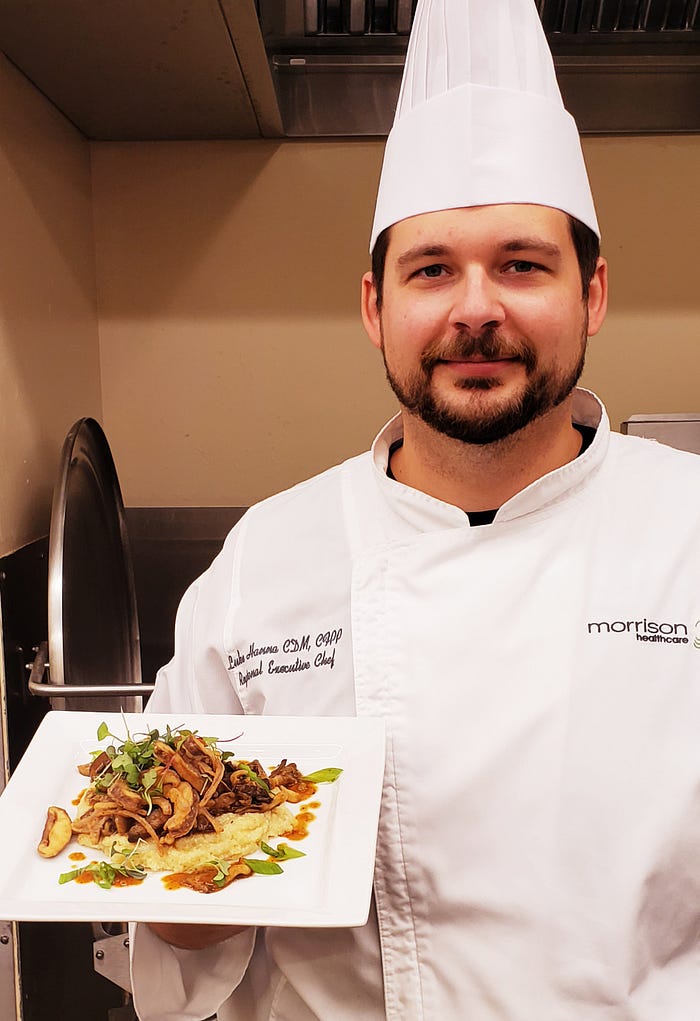
Meet the chef
Luke Hanna is from a small town in Maurepas, La. His love for cooking began from childhood whenever his family decided to open up a small diner. This led him to go to culinary school to pursue a career in the food service industry. After 13 years in fine dining restaurants and health care, Hanna is now a regional executive chef for Morrison Healthcare. Luke Hanna is very passionate about food, and he continues to elevate every experience for the customer, patient, and even his own team! Hanna has a keen eye for even the smallest of detail and is innovative both on and off the plate.
What is the story of your recipe?
I was born and raised in — literally — the swamps of Louisiana. If there was a decent rain, the flood waters would rise, and it’s not uncommon for alligators to swim by the front door. The closest “branded” grocery store was 45 minutes away, which is important to understand the lifestyle of all of the past generations of the Hanna Family.
This whole competition spoke to me, because I come from a family that does not waste anything and if the family hunts were not fruitful, then they had to depend on the vegetables that were grown in the garden. This carried on through all the generations, up to my father. Back home, the Hanna family always lived in one particular home in Maurepas, La. Still, to this day, my father lives there. In the past, the Hannas would build a homestead. There would be livestock to tend to and a massive garden to cultivate. Once the land became barren, my family would literally tear down the house and homestead, move it a mile down the road, then start again!
Although I didn’t go through the extreme hardships of my family, I do try to live in the lifestyle of my family. I believe in zero waste and in ensuring my creations utilize anything that is left.
This is where I drew my inspiration from for this recipe. You will see that with a couple techniques in this recipe; mushroom stock, green onion usage, etc. Then being from south Louisiana, grits is just a household staple. My ancestors would turn in their grave, if that isn’t the best grits you have ever had!
How did you feature your recipe?
We marketed my dish by the basics of “come try this contest entry.” We marketed “what” the dish was: grits and grillades prepared by a South Louisiana Chef. With most folks being from Mississippi, that alone sparked some interest.
The biggest marketing ploy for myself, which I spoke about to every customer that came into our café, is the overall sustainability of my dish. Given my family’s past, this is important. Mushrooms are an extremely sustainable product. They have a potential to grow hundreds of pounds, up to a ton, per acre of land! That is extremely impressive. Let alone from having a literal ton of mushrooms laying around per acre — we don’t have to tear up vast amounts of land to grow vegetables. They are efficient on water consumption, so they don’t need near as much water to grow. With not as much watering going on, we now don’t have to burn as much fossil fuels to be able to water. Now, the atmosphere is cleaner. The lists go on and on… Whenever you explain this to our customers, they want to do their part in sustainability.
Stay tuned for our announcement of the winner in March…

*Correction. An earlier draft of this article included Mayo Clinic Arizona and University of Mississippi Medical Center in the top 5 finalists. These two facilities are in top 7 of all contest entrees but are not top 5 finalists.
